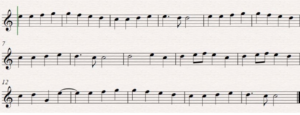How I Learned to Love SCALES!
by Naomi Perera
I have a confession to make. I actually love playing scales. I know, I know, what sort of a loser enjoys scales?? But I wasn’t always this way, in fact, all the way through school, university and beyond I loathed and dreaded playing scales, putting it off and feeling guilt and anxiety for how often I skipped them.
It wasn’t until I stopped drilling them as scales and started playing (and listening to) them musically that my mindset changed. And it transformed my playing. The power of muscle memory is a beautiful thing. Those tricky bars of descending thirds? No problem, I've got an exercise for that. How about those 'oh so perfect' Mozart semi-quavers? I've got you covered! They're just scales. Once your hands know the shape of the music it all comes together with so much more ease.
It doesn't need to be painful. There's nothing wrong with doing a simple quaver up-down scale but why is that all we do? As teachers, if we only teach scales as a tick box for an exam, we’re short-changing our students and imbuing the practice of scales with anxiety. Be musical. Be creative.
Here are a few ideas to get you started.
Change the articulation. The simplest way to add interest is to change the articulation. Even in the grade 1 exams, they ask for slurred scales, meaning every note should be joined. But why not add slurs inside the scale? Try joining the first 3 notes only, or letting the 4th and 5th note shine out and slur the rest.

Rhythm. The next most obvious way to add interest is to vary the rhythm. You will probably want to still keep a steady pulse but rather than only playing straight quavers you could swing them, or add semiquavers, or mix and match different rhythms to create an interesting tune.

Direction. Why start on the bottom tonic note? Try descending from your tonic, or starting on the 5th...or 4th..or 2nd...

Repeating notes This is another way for you to practice creating your own simple tunes. You could repeat the second note twice, the third note 3 times, etc. Or you could repeat every other note. Or you could just repeat the first and last. Use your imagination.

Practice other techniques Bill Gates allegedly once claimed that he hired lazy people because they would find the easiest way to get a job done (Bill Gates, if you're reading this, I'm your perfect candidate). Hit two birds with one stone by practicing another technique along with your scales. If you're practicing vibrato you could do a slow rise varying the speed of the vibrato on each note. Or you could start slowly double tonguing notes and then speeding up faster and faster.

Leaps Of course, music doesn’t always follow stepwise patterns so it's definitely a good idea to put some leaping patterns in your scale practice. Start off with 3rds, ascending or descending, and then start practicing your 4ths, 5ths - add some breath practice in by practicing leaps over an octave going up a scale.
Transposing a well-known tune Choosing a tune you know really well, transpose it from memory. Ode to Joy anyone?

Improvise! But my favourite way to both practice and teach scales is to improvise. Once you're feeling comfortable with the notes, try and combine them in different ways using the techniques above. See what different moods you can create using different scales and see how you create changes daily. I start most days with improvisation, and this unstructured playtime allows me to ease into my sessions with joy. I also encourage my students to improvise and sometimes giving them the space to focus entirely on one factor (for example a scale) without worrying about reading, or rhythms, or the myriad other things normally on their minds, finally help them 'get' it.
And as with everything flute, your ears are your best friend. Play mindfully, listening super carefully for all the nuances of tone and sound. I wish you and your students joy in your scales!
Naomi Perera is a performer and teacher based in Yorkshire, UK, whose practice places contemporary performances in alternative contexts. Her playing has been witnessed extensively across Europe with a diverse range of acts from Cosmic Disco to Indian Fusion and she holds an MMus in Creative Musicianship from Leeds College of Music. Following is an article Naomi first published on her blog, published here with her permission.
